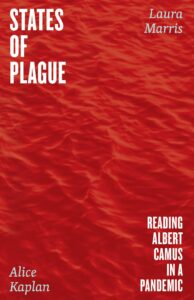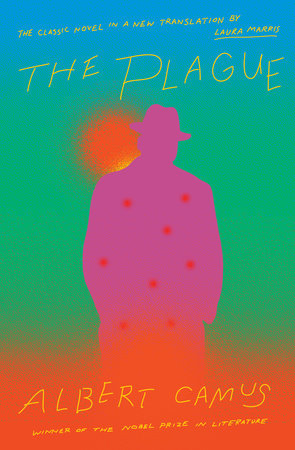
[University of Chicago Press; 2022]
In the hot summer of 2020, we marched by the tens of thousands down the streets of Chicago, chanting the names of George Floyd, Breonna Taylor, and others. For most of us, it was the first time we’d seen so many people in one place since the pandemic began. We were outdoors but all masked. We were angry but hopeful. We were marching together but no faces were visible, and rage poured from behind cloth.
At one point, the march funneled into an underpass on Ashland, a narrowed space flanked on either side by wary police. The burning totality of that dark and claustrophobic year seemed to all be there in that dark and claustrophobic tunnel, where our bodies were mashed together but it was impossible to hear. We were throttled by anger and threatened by power, and the indifference and cruelty of that awful year seemed to catch in our choking lungs. That moment seemed like the pandemic made concrete.
The search for metaphor—the struggle to name something, to make it make sense—when the world is upside down is not a new one. Language, writing, building a mental structure around the unnamable: it’s how we try to assign or find meaning in the shapelessly meaningless. It’s what drove Albert Camus to write The Plague, a complex metaphor for the rampaging horrors of fascism. And the search for meaning in his novel runs through States of Plague: Reading Albert Camus in a Pandemic, an intriguing and surprising conversation of essays by Alice Kaplan and Laura Marris.

Marris, a writer and translator who recently completed a vital new translation of The Plague (released in late 2021), and Kaplan, the Sterling Professor of French at Yale (among many other positions), conceived of the book before the pandemic struck. It was to be a series of conversations about the work, and in many ways it still is. It’s a delight to read two experts explore the familiar—a canonical novel—with a level of knowledge and insight few of us, least of all me, possess.
The way the two writers separate their work seems at first to be concrete: Kaplan would “engage the forces of history,” and that seems to be the case. Her insight into the history and geography of Oran, the plague-ravaged Algerian city in which Camus set his work, Camus’s personal history, and the tumult of the war years in which the novel was written, bring wonderful details to life, while also zooming out to see the big picture.
Kaplan notes that Camus originally wanted to call his book Les Séparés, the separated, a term that was more about the people than the disease itself. That’s what his fictional pandemic—and our real one—ended up doing. We were separated from each other in so many ways: those who followed commonsense health and safety guidelines from those who refused, those at home and those on the frontlines, those who were alone and those who were together. A pandemic, like a war, is universal, but as Kaplan says, it isn’t universally felt.
In exploring these ideas, she ties interesting connections to a Camus notebook on World War II which seems relevant to the idea of the separated. Noting that four out of five French repatriated prisoners of war got divorced, Camus rues that “80% of human loves do not resist five years of separation.” Resist, in 2020, was a resonant word. Marris expands that idea of separation for our time:
The ways and means of separation and communication during the current pandemic would have been inconceivable to anyone in Camus’s generation, yet the deep processes he describes have helped me understand the strange postmodern forms of separation mediated by technology. How many lovers have been separated, how many “ghostly dialogues” have been carried on across the globe on Zoom or FaceTime?
Our ways of staying together felt like simulations; pale echoes of the real thing, a Hollywood Squares-style overlap of “sorry, you go” while talking over everyone else. But while seeing faces made a difference to us, the isolation, the fear, the breaking of actual communication, and the lack of touch draws together Camus’s worlds and our reality.
Marris has a slightly different brief, as she is “drawn to the ecology of landscape and language.” Many of her chapters deal directly with translation, and what it actually means to use the right words, to get it right. As a lover of translation and an idiot with language, I admit these discussions thrilled me.
In a chapter titled “Restraint,” Marris discusses Camus eschewing metaphor in The Plague, and choosing to look at the world as it is. She criticizes some immediate post-war translations for meddling with the plainspoken sentences “to make them closer to heroic postwar rhetoric.” As an example, she translates a sentence with a weary but determined “they must begin again.” An earlier translation took the same source but rendered it “they must set their shoulders to the wheel again,” which is nice but feels like human beings flattening into a propaganda poster. Continuing in that vein, she explains:
These inner workings or restraint are counterintuitive—often the less drastically the writer expresses an emotion, the more forcefully a reader can feel it. Naming a feeling or conjuring it through elaborate flourishes can be deflating, reductive. Camus’s lack of stylistic padding enables him to make his work harrowing.
This is not, to me, insider shop talk about translation, or even just direct literary criticism. The idea of restraint, of holding back, or avoiding flourishes to name the thing as it is, was strained and difficult in the early part of the pandemic. It was either ironized as “the panny” or some such flourish, or muttered with a distancing, unnamed, “I just, yeah, it’s really fucking wild.” But that kind of ironic distancing couldn’t last. The pandemic was so big and so overwhelming and our screens were so filled with body bags and the air so choked with sirens and a feeling of dread everywhere that we were forced to find a way to name it.
As Kaplan, who was living in France in March of 2020, points out, President Macron reversed Camus’s metaphor, and invoked the specter of war. Naming it this way made the horrors legible, but did so in ways that shaped the government’s approach to the disease. Macron tried to unify the people by drawing on the French memory of World War II, unified against a common enemy. Obviously, not all French resisted the Nazis, so the idea of unity wasn’t historically accurate. But national myths don’t require accuracy.
The United States also invoked war as a metaphor for the pandemic, but of course the US has had a much different experience of war. For the US, war has always been distant, intimate only to those areas in which the US is fighting or occupying. The dying happens elsewhere, and increasingly, is conducted by a very small clique of distant professionals. As is fitting, we were being . . . well, “led” isn’t the right word . . . harangued nightly by a selfish black hole of depthless insecurity, and the war metaphor became a license to resist the idea of cooperation. The number of people who said they weren’t going to be scared of the pandemic, like they were facing the Blitz in London, turned the idea of sacrifice upside down. Outside the tireless front-line workers, heroism for most of us meant accepting the idea of restraint. It meant isolating with ghostly calls and lonely walks. Restraint helped us understand what it meant to serve others. As Marris says, “Restraint isn’t for the writer; it’s for the reader. By holding back the dazzle for a moment, a writer can let someone look directly through the page, at the part of the world that hurts.”
As their book continues, Marris and Kaplan find more of these harmonies between Camus’s time and ours. Reflecting on what comes next in “The Ends of Wars and Plagues Are Messy,” Kaplan traces the end of the fictional plague in Oran with the liberation of Paris, and the waves of retribution against Nazi collaborators that followed. Camus was initially in favor of swift and harsh punishment, to burn the plague of fascism from the country, although he evolved his position, lining it up with his lifelong abhorrence of capital punishment.
Reading this now, it’s hard to understand my own feelings. In our time, fascism is again infecting the United States, amongst other countries. The plague year, after all, tumbled into an months-long attempt to game a clear-cut election, and ended with right-wing militias storming the capitol to either intimidate or kill people in order to stop the constitutional process. And the same intellectual pathogens that have fostered fascism in this country helped make our plague a reaping killer, cutting swathes of death and misery across the land.
It seems unreal and forgotten that the horrors of that year are still with us, still ongoing, but the trauma has been buried. The violence in the streets, the power of the state being used to break protests, unmarked feds pulling people into unmarked vans. The dead in the tens and then hundreds of thousands. In some ways, it feels as distant as Camus’s war and as fictionalized as his plague.
It isn’t distant, of course, and reading this fascinating and often meditative collection of essays by two subject experts who are skilled readers and gifted writers helps us understand the sheer importance of looking. Even if metaphors fail, even if language only serves to illuminate what is impossible to beautify, seeing what is happening in the world is the only way to engage it.
Brian O’Neill is a freelance writer who mostly enjoys writing about books—small press fiction, memoirs, the Midwest, and international politics. Also, baseball. He tweets about all of that @oneillofchicago.
This post may contain affiliate links.







